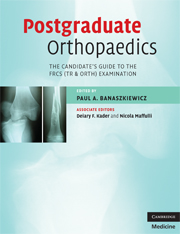Book contents
- Frontmatter
- Contents
- List of contributors
- Foreword by Mr Peter Gibson
- Preface
- Glossary
- Section 1 The FRCS (Tr & Orth) examination
- Section 2 The written paper
- Section 3 The clininicals
- Section 4 Adult elective orthopaedics oral
- Section 5 The hand oral
- Section 6 The paediatric oral
- 22 Paediatric oral topics
- Section 7 The trauma oral
- Section 8 The basic science oral
- Section 9 Miscellaneous topics
- Index
- References
22 - Paediatric oral topics
from Section 6 - The paediatric oral
Published online by Cambridge University Press: 22 August 2009
- Frontmatter
- Contents
- List of contributors
- Foreword by Mr Peter Gibson
- Preface
- Glossary
- Section 1 The FRCS (Tr & Orth) examination
- Section 2 The written paper
- Section 3 The clininicals
- Section 4 Adult elective orthopaedics oral
- Section 5 The hand oral
- Section 6 The paediatric oral
- 22 Paediatric oral topics
- Section 7 The trauma oral
- Section 8 The basic science oral
- Section 9 Miscellaneous topics
- Index
- References
Summary
Introduction
The paediatric oral topics section is a brief overview of some of the more important paediatric topics that tend to regularly appear in the examination.
The paediatric oral can be tricky as the examiners expect you to have both a comprehensive range and depth of paediatric knowledge. Candidates may struggle unless they have had a reasonable working exposure to paediatrics, ideally 6 months as part of a higher surgical training rotation. Some topics are very predictable – in the oral candidates will invariably get one of the big three (DDH, Perthes and SUFE), not infrequently all three.
The paediatric oral for the most part consists of clinical photographs and radiographs acting as props to lead you into a particular topic. Occasionally a video of gait analysis in a CP patient is thrown in at the end to stretch you.
In general candidates can come across two types of oral:
A series of rapid-fire clinical photographs and radiographs. A spot diagnosis of the topic and from this a fairly superficial/generalized discussion about management of the condition.
In the second oral type fewer topics are covered but there is a greater probing of paediatric knowledge, particularly management issues.
The key elements for success in the oral are:
To have worked for 6 months in a paediatric orthopaedics higher surgical training job
Correctly gauging the depth of paediatric knowledge required for the oral. Aiming too high can be a disaster; too low and you will fail
Similar principles apply with your reading material. Some paediatric books are a little flimsy, whilst others are subspeciality textbooks that are difficult to revise from
[…]
- Type
- Chapter
- Information
- Postgraduate OrthopaedicsThe Candidate's Guide to the FRCS (TR & Orth) Examination, pp. 359 - 400Publisher: Cambridge University PressPrint publication year: 2008

